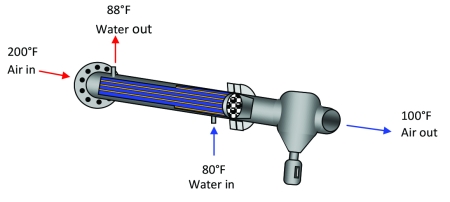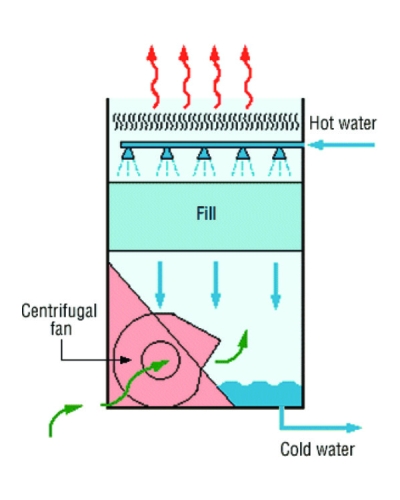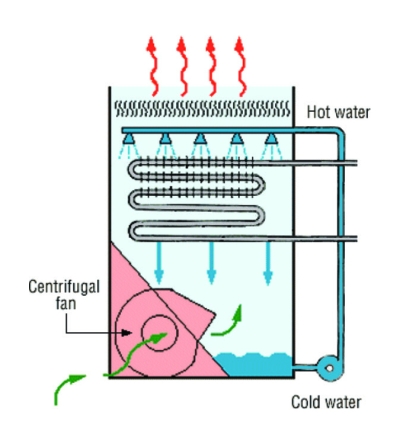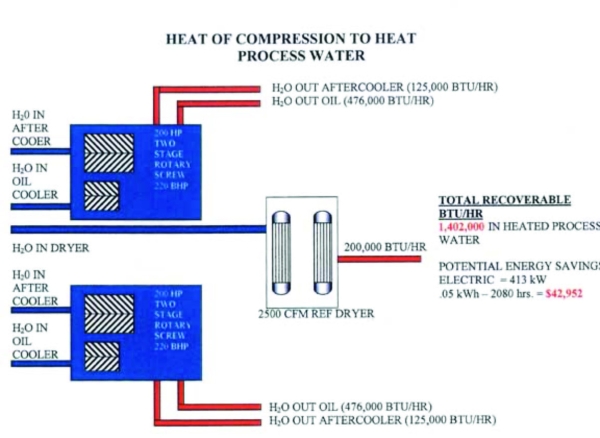08/31/2023
This is a two-part article looking at factors impacting decisions on whether to use air or water-cooled air compressors. It also provides heat recovery guidelines for both situations. Part 2 will provide a review of alternative cooling water system options and their approximate operating costs.
Most air compressors are designed to receive cooling water at the required flow with a maximum inlet temperature of 100°F (38°C). Some air compressors may accept up to 110°F (43°C) and expect maximum discharge water temperature of 120-130°F (49-54°C). These values should be kept in mind when evaluating any air compressor cooling system.
Compressed air dryers, in the U.S., their flow capacity rating (scfm) at inlet compressed air conditions of 100 psig (7 bar) and 100°F (38°C). If inlet air temperatures to the dryer rise above 100°F, the moisture load per scfm to the dryer will increase significantly, reducing the amount of flow the dryer can handle, if it’s to maintain dew point.
When evaluating the cooling system for the air compressor, the aftercooler performance must be considered. For proper application and sizing of the dryer, one must be aware of the compressed air inlet temperature to the dryer and its design approach temperature to the incoming cooling media temperature – air or water.
Alternative Cooling Water Options and Auxiliary Trim Cooling for Air Cooled Systems
Recirculation cooling water ponds were and still are an option for a locally controlled cooling water system supply. As long as the pond is large enough to handle the heat load under the worst condition and maintain an acceptable temperature, it can be very effective, particularly in large installations. They do have some inherent limitations:
- Significant water loss due to ambient evaporation
- Continued buildup of silt in the pond may significantly reduce its heat absorption capability and not remain usable
- Water treatment is still necessary
- Makeup water is usually with some kind of expense – i.e. well pump, etc.
- A pumping station is still required to circulate the cooling water
If analysis indicates a problem in hot weather, then appropriate action must be taken. One solution is a trim cooler. Generally speaking, cooling air or water flow is set up counter flow to the hot air flow whenever possible. Note it is important that cooling water enters the bottom of a horizontally mounted tube-in-shell water cooler; be sure to keep a full water charge under all flows and as shown, the cooling water flow is counter to the air flow.
Unless the cooling pond or a trim cooler works, the next alternative is to some type of a centralized cooling water system.

Figure 1. Typical water to air trim cooler. Note: proper piping involves water inlet at bottom so water flow is counter to compressed air flow.
Centralized Cooling Water System: Open Evaporative Cooling Tower
The lowest capital cost centralized cooling water system is the open tower type evaporative cooling tower. In this type, the heated return water flows down a controlled open path where it is cooled by the continual evaporation by moving ambient air from a fan and pulling an evaporating water percentage into the ambient air. These towers will have a smaller circulating pump to move the water through the cooling area and a large horsepower electric motor fan to move ambient air over and through the cooling water to optimize the evaporation cooling. There is also a flushing or blow out system using water.
The primary benefit of this type of system is that as the ambient temperatures increase, generally so does the evaporation rate which means, in most North American locations, they will deliver about 85°F (29°C) temperature cooling water when operating properly within their design limits.
Open cooling towers are very prevalent throughout industry and are often known affectionately as very effective “air washers” meaning they remove the dirt and impurities from the ambient air, generating a continual cleaning of the tower maintenance issue, the frequency of which is dependent on the ambient conditions and after the season of the year.
The contamination factor along with the high level of make-up water required makes proper and diligent water treatment and condition monitoring a prerequisite for a successful installation. Open towers also inject oxygen into the process water system which may or may not create corrosion or other maintenance issues.

Figure 2. Forced draft, evaporative, counter-flow cooling tower
Centralized Cooling Water System: Closed Cooling System with Auxiliary Evaporation Cooling Assist for Hot Weather
In this type of system, the primary coolant is sealed in a closed loop system and unexposed to ambient air. The coolant may be water, but it is more often a glycol water mix appropriate to the local ambient cold temperature limitations. This is very good for the equipment being cooled since it runs for a significantly long time without significant water treatment requirement or replenishment.
The cooling system is equipped with a motor driven spray pump and spray header which delivers a spray over the air cooled heat exchangers during hot weather and creates evaporation auxiliary cooling similar to the open tower described earlier.

Figure 3. Typical closed circuit fluid cooler with evaporator
Centralized Cooling Water System: Closed Loop Cooling with Evaporation
Obviously there is additional water use, the magnitude very much dictated by the ambient conditions. There is also a motor driven coolant circulation pump and motor drive main cooling air fan similar to the open tower. The standard pumping station is also required. Some flushing or blow may also be required.
Depending on design and operating conditions, this type of cooling towers use parallel flow or cross flow or counter flow. Compared to an open tower with evaporative cooling, the closed circuit cooling system has a higher initial cost but also some advantages which may be significant when the operating conditions dictate.
In a compressed air system, the process water must be capable of full capacity throughout the year. This means maintaining a clean, reliable cooling fluid loop is critical. To do this in an open tower requires proper and diligent water treatment and maintenance. The closed loop system is basically isolating the compressor cooling fluid from all air ambient out borne contaminants:
- This reduces the frequency of the need to shut down the cooling system for cleaning.
- This type cooler has a lower volume of recirculating water requiring water treatment filtration
- The compressor cooling fluid usually requires minimal treatment
- During periods of dry operation (cooler weather) the need for spray evaporation and therefore makeup water is eliminated
- These units, like many central cooling water systems, are set up with either another cooling water source or chiller cooler. These trim coolers cool the fluid from the primary cooler when required by too high a temperature.
Centralized Cooling Water System: Dry Air Cooling System – No Water Required
These coolers are also a closed loop cooling system usually using an appropriate water glycol mix passing through finned tubes. The coolers are in modules each with a small fan for air cooling. As the heat load is reduced the fans are shut off individually as required and brought back on when needed. This type of closed cooling systems are usually available from 160,000 btu/hour rating at 250 cfm class to 4,000,000 btu/hr rating at 6,000 cfm class with specials to other levels.
These air-cooled heat exchangers can be manufactured to deliver a 2°F approach temperature but economics usually dictate a 5°F approach. This means in parts of the country they may be able to handle a reciprocating compressor’s cooling needs with little or no trim cooling.
Rotary screw, vanes and centrifugals are usually limited to 100°F or at the most 110°F inlet cooling water temperature when properly equipped and because of this an effective trim cooler is almost always recommended. The trim cooler also creates a situation where heat recovery in the form of heated fluid or water can create direct energy savings.
Figures 4 and 5 sketch an installation of two, water-cooled, 250-hp, two-stage, lubricant cooled, rotary screw air compressors along with a water-cooled, heat sink, cycling, refrigerated compressed air dryer. The plant manufactures dry dog food and used a great deal of hot process water coming from the nearby production lines.
A trim plate and seal cooler was installed with a small 2.5-hp pumping station and the 60°F (16°C) process water was run through the trim cooler and heated to 94°F (34°C) or more.
The calculated savings was 1,402,000 btu/hr which offset \$42,952 of the previous process heating water equipment. At the conclusion of the project the annual measured savings was \$61,482 per year due to the pre-cooling of the return heated fluid to the air cooler. For one full year while monitored no more than two of ten fans ever ran, even during the summer. In the winter almost none ran.
In this case, there was a ready supply of cool trim water available which the plant was already using for process water; however, that is not always the case.
Evaluation should always include the cooling method and cost of the trim coolers. Generally, the amount of auxiliary cooling is low except in emergency situations.
A chilled fluid closed cooling system is another excellent selection for this application. Again, a closed loop system with a glycol water system can cool effectively, and well controlled, will only use the required energy to accomplish the goal. Chilled fluid cooling can also be combined with a secondary cooling water backup service.
As you can see, all these options offer a great deal of flexibility and can effectively cool “water-cooled air compressors” using no water.

Figure 4. Heated cooling water always has some heat recovery opportunities. Click to enlarge.

Figure 5. Heat recovery piping schematic of system shown in Figure 4. Click to enlarge.
Comment on Utilizing Central Cooling Systems – Open or Closed with Air Compressors
With the exception of large water-cooled reciprocating air compressors, most rotaries and centrifugals have relatively high-pressure losses through them compared to many other commonly fluid cooled industrial equipment. Whenever possible, each air compressor or group of compressors should be on its own system to avoid other pressure losses reducing the flow to the air compressors.
An effective trim cooler should be well controlled to effectively modulate the flow and manage the power use. Often these trim coolers are sized to be able to handle 100% of the load and keep the equipment running in the case of an emergency.
The energy use of the circulation pumps is a function of the flow volume and the head. Poor fluid piping, sizing and configuration, can add pressure loss and head. Installing the cooler farther away from the air compressors, or on the building roof, will also usually increase the cooling fluid “head” and require larger pumps.
Summary
Table 1 provides a comparison of cooling system operating costs between; water-cooled full flow; open evaporative tower; closed system evaporative; and dry air system with trim.
These are very conservative numbers and we caution again to be sure to gather your equipment and site specific data. There are also other options that can be added or mixed in with these basic technologies to offset some of the inherent inefficiencies such as:
- Chilled water or alternate cool water to trim the cooling and reduce the “top end” heat load on the primary central cooler.
- VSD drives on the large cooling fans particularly utilizing the new, permanent magnet, VSD drives.
- Automatic level control and heaters on the pan fill.
- Automatic drain in the pans.
It is evident that any of these options are preferable to “once through” municipal water. The ever-growing regulations and controls will just further increase this differential in cost.
The true cost of the open evaporative tower and the closed loop evaporative tower can be driven much higher with more significant water treatment costs, water disposal regulations, sewer costs and surcharges. The cost of the dryer cooler with trim is very predictable.
|
Compressor Cooling |
1000 btu/hr |
gpm |
||
|
After-cooler |
1547 |
124 |
||
|
Oil-Cooler |
145 |
29 |
||
|
Total 1,000 btu/hr/gpm |
1692 |
153 |
||
|
|
||||
|
|
Once through Municipal Water |
Open Evaporative Water |
Closed Loop Evaporative Tower |
Dry Cooler |
|
Water cooled for compressor cooling |
153 gpm |
Recirculated |
Recirculated |
N/A |
|
Total gallons/year at \$3.00 / 1000 gallons |
78,948,000 |
N/A |
N/A |
N/A |
|
Spray circulation pump motor at \$.06 kW / 8600 hrs/yr |
N/A |
kW / 100% |
kW / 30% |
|
|
Main cooling system fan driver motor kW/yr at \$.06 / 8600 hrs/yr |
N/A |
75-hp |
11-hp |
(12) 1.5-hp |
|
Evaporative make up water – gpm |
N/A |
3.4 gpm |
1.2 gpm |
N/A |
|
Flushing blow out water – gpm |
N/A |
45.9 |
1.7 |
N/A |
|
Total Gallons of Water for Water Treatment |
78,948,000 |
25,438,400 |
1,496,400 |
N/A |
|
Water treatment costs at 42 grains hardness, 10 alkalinity, with biocide treatment at \$1.20 per 1000 gallons |
\$94,737 |
$\30,526 |
\$1,795 |
N/A |
|
Trim cooler costs to operate during extreme hot weather; chiller cooler kW/% time at \$.06 kWh/8600 hrs/yr |
N/A |
N/A |
N/A |
30% utilization |
|
Pump station electric motor kW – based on 160 gpm, 100 ft of head specific gravity 1.0 |
7 kW |
7 kW |
7 kW |
7 kW |
|
Total Operating Cost Water \$/yr |
\$335,039/yr |
\$136,666/yr |
\$13,350/yr |
\$9,649/yr |
Table 1. Direct Cooling Water/Fluid Comparison of a 600-hp, 3-Stage Centrifugal Air Compressor rated for 2,750 scfm at 100 psig at 590 bhp.
For more information on APenergy visit www.apenergy.com or call 740.862.4112.
To read Part 1 of this article, visit https://www.airbestpractices.com/technology/cooling-systems/evaluating-air-compressor-cooling-and-heat-recovery-part-1.
To read similar Cooling Tower Technology articles, visit https://coolingbestpractices.com/technology/cooling-towers.
Visit our Webinar Archives to listen to expert presentations on Cooling Technology at https://coolingbestpractices.com/magazine/webinars.

